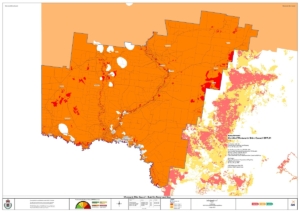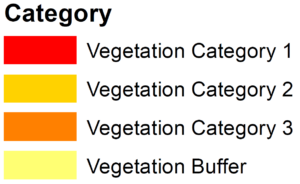Bushfire Prone Land
A bushfire prone area contains or is near vegetation that has the potential to come under bushfire attack. If your land is located in a bushfire prone area then certain protection measures must be considered when designing a new development.
Wentworth Bushfire Prone Land Map
The Wentworth Bush Fire Prone Land Map identifies land with vegetation that may support a bushfire or that is likely to be subject to a bushfire attack. The map has been prepared by the NSW Rural Fire Service (RFS) in consultation with Council and certified by the Deputy Commissioner Preparedness & Capability.
Bush Fire Prone Land mapping identifies vegetation types and associated buffer zones. Bush fire prone land mapping is designed to flag a property that has the potential to be threatened by bush fire and to initiate an assessment under the NSW RFS publication Planning for Bush Fire Protection 2019 to determine whether land management and or building construction measures need to be adopted to help safeguard the development, its occupants and neighbouring properties from bushfire.
Vegetation Category 1 – Red
Land considered to be the highest risk for bush fire and surrounded by a 100-metre buffer. This vegetation category includes woodlands and timber plantations and has the highest combustibility and likelihood of forming fully developed fires including heavy ember production.
Vegetation Category 2 – Light Orange
Land considered to be a lower risk for bush fire and surrounded by a 30-metre buffer.
This vegetation category has lower combustibility and/or limited potential fire size due to the vegetation area shape and size, land geography and management practices.
Vegetation Category 3 – Dark Orange
Land considered to be medium risk for bush fire and surrounded by a 30-metre buffer. This vegetation category includes grasslands.
AS3959 introduced grasslands as a threatening vegetation type in 2009. In 2015 Vegetation Category 3 was introduced into the Guide for Bush Fire Prone Land Mapping (Version 5b) to assist Councils with the transition into the new vegetation mapping category.
Vegetation Buffer – Yellow
Adjoining area that is determined to act as a buffer to the relevant vegetation category
All applications submitted from 31 July 2023 will be assessed against the Wentworth Bush Fire Prone Land Map (certified 31 July 2023).
New Development on bushfire prone land
New development located on bushfire prone land is subject to the controls of the NSW RFS and Planning for Bush Fire Protection. Depending on the type of approval you are applying for, you’ll need to undertake additional steps in the preparation of your application for your development.
Development applications
All new developments on bush fire prone land in NSW are assessed against the requirements of Planning for Bush Fire Protection 2019. For the assessment of new single dwelling developments located on bushfire prone land, a NSW RFS Bushfire Assessment Report must be attached to your application.
As part of our assessment process, we may establish a Bushfire Attack Level (BAL) rating. This rating helps determine what bushfire control measures you may need to implement as part of your development.
Complying development
The NSW Department of Planning (DoP) and the Rural Fire Service (RFS) have worked together to introduce a new system which allows complying development on some bush fire prone land (i.e. low risk bush fire prone land), but importantly maintains a rigorous assessment regime for managing bush fire risk.
A new certification process has been introduced whereby the risk of bushfire is assessed by an application for a Bush fire Attack Level (BAL) Certificate. Once the BAL has been determined and the certificate has been issued, the applicant may proceed with applying for a Complying Development Certificate (Note – complying development is not allowed on high risk bush fire prone land – i.e. where the BAL is identified as 40 or Flame Zone).
Upon receiving an application for a Complying Development Certificate which is accompanied by the required BAL certificate, Council or the accredited certifier must then certify that the proposal complies with Planning for Bushfire Protection 2019, Australian Standard 3959-2009 – Construction of buildings in bush fire-prone areas (AS3959) and other applicable development standards.


